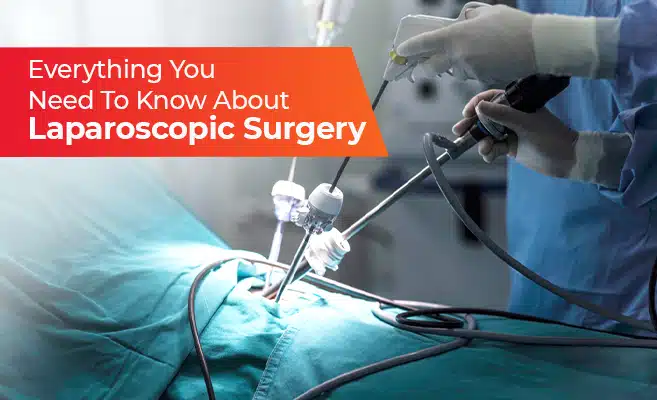Everything You Need To Know About Laparoscopic Surgery

A surgical diagnostic process performed to evaluate organs inside the abdomen is known as laparoscopic surgery. It is also termed diagnostic laparoscopy, which is also performed to examine closed spaces, for example, knees. In this kind of surgery, only small incisions are needed. Thus, it is a low-risk and minimal diagnostic process.
While carrying out a laparoscopic surgery, doctors utilise a special instrument named a laparoscope that helps examine the abdominal organs. It is an essential instrument with a thin, flexible and long tube. It has a high-resolution camera and a light with high intensity attached to its front part. The doctors make an incision in the walls of the abdomen and insert the instrument through it. The camera sends the images captured by the instrument to a video monitor.
The doctors can see what is inside the body without a large incision with the help of laparoscopy. The doctors can also gain the biopsy samples while performing this procedure and do the surgery too.
Why is Laparoscopic Surgery Done?
The major cause behind performing a laparoscopy is examining, recognising, and diagnosing the reason associated with pelvic or abdominal pain. If the noninvasive ways are not able to identify the cause, the doctor goes ahead with the laparoscopy. However, many cases can only be diagnosed with the picturing technique. Mentioned below are some of the cases identified with imaging techniques.
- CT scan- A series of special X-rays are taken to observe the cross-sectional area of the body.
- Ultrasound- It uses multiple high-frequency sound waves to create images of the body.
- MRI Scan- It helps produce body images by utilising radio waves and magnets.
If these tests cannot give sufficient information or insight for a particular diagnosis, then doctors opt for laparoscopy. The processes involved in the laparoscopy might also be utilised for taking the tissue sample, a biopsy, etc., from a specific organ in the abdomen. Mentioned below are some of the organs in which doctors are supposed to perform laparoscopy.
- Liver
- Stomach
- Appendix
- Small intestine and large intestine (colon)
- Gallbladder
- Reproductive or pelvic organs
- Spleen
- Pancreas
The regions detected by a doctor with the help of a laparoscope are as follows:
- Liver disease
- The degree of a particular cancer increment
- An abdominal tumour or mass
- Particular treatment is working or not
- Fluid in the abdominal cavity
In some cases, the doctors also begin the intervention for treating the condition immediately once the diagnosis is made.
What is the result of a Laparoscopic Surgery?
The doctors who specialise in the analysis of tissues are known as pathologists. A pathologist is responsible for examining the biopsy taken. The doctors will get a detailed report about the results sent by the pathologist.
In the normal outcome of a laparoscopy, an absence of abdominal bleeding, intestinal blockages, and hernias are indicated. Thus, it indicates that all the organs are healthy and have no issues. However, if the results obtained from the laparoscopy are abnormal, it might point out the certain issues such as:
- Cysts or tumours
- Hernias
- Cancer
- Trauma or injury to a specific organ
- Fibroids, or abnormal growth in the uterus region
- Adhesions or surgical scars
- Pelvic inflammatory disease, an infection of the reproductive organs
- Appendicitis is an inflammation of the intestines
- Cholecystitis, an inflammation of the gallbladder
- Endometriosis is a disease in which tissue similar to the lining of the uterus grows in other places in your body.
The doctors usually plan and schedule an appointment with the patients to discuss the outcomes of the test. They support and make the patient calm if their results are found to be serious. They help them by recommending them the best-suited treatment choices to the patients. They also form the best possible plan to make the treatment go well and address the medical condition.
Benefits of Choosing Laparoscopic Surgery Instead of Other Methods
In today’s world, people usually opt for surgery with laparoscopy. Mentioned below are some of the major reasons why doctors and patients prefer to go ahead with this surgical type rather than the others.
- It does not make larger scars.
- Very few tissues are cut in this surgical procedure.
- Stay for fewer days in the hospital (In traditional methods, a patient’s recovery time was 4 to 8 weeks, and hospital stay was 1 or more than a week. However, in laparoscopic surgery, recovery time is 2 to 3 weeks, and hospital stay is only 2 nights).
- People often get back to their normal life soon.
- The risk of getting an infection is less because the exposure of internal organs decreases from the contaminants present outside.
- The use of pain relief medicines is less.
- The scars are small and can heal easily.
The Bottom Line
The methods involved in surgery have evolved tremendously over several years, and the laparoscopic surgical method is one of them. It is a very safe and better method to perform surgery. It is quite beneficial for the patients and helps increase their quality of life. Explore the website to know more.

 Book An Appointment
Book An Appointment Virtual Consultation
Virtual Consultation





